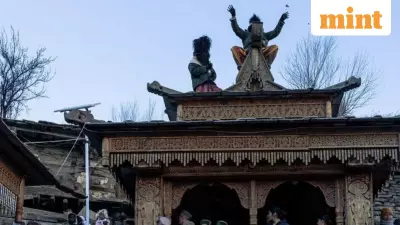
While India commemorates the 150th anniversary of its revered national song, Vande Mataram, a different, more somber battle is being waged at its very birthplace. Far from the political credit wars surrounding the song, the historic 'Baithakkhana' in Kantalpara, West Bengal, where poet Bankim Chandra Chattopadhyay penned the iconic verses, is fighting a desperate struggle against official neglect and public indifference.
A Legacy Fading in Kantalpara
Approximately 45 kilometers from Kolkata, in the North 24 Parganas district, stands the red-and-beige, single-storeyed Bankim Bhavan. This building, with its distinctive shikhara domes and arched doorways, houses the Bankim Bhavan Gaveshana Kendra Museum. Within its pastel-blue rooms, a precious collection competes for space: a bronze bust of the poet, his handwritten music book, a shawl, and a turban, all lined with fading family photographs.
This three-room parlour was where the 19th-century literary giant wrote Vande Mataram. Today, the signs of decay are unmistakable. Seepage marks the walls, lighting is poor, and there is a critical absence of air conditioning to protect the fragile artefacts from the humid Bengal climate.
Ratan Kumar Nandi, the director of the research centre that manages the museum, acknowledges the dire need for upkeep. "It’s true that the rooms where Bankimchandra Chattopadhyay’s personal items are kept need upkeep," he states, adding that renovations to address the dampness are slated to begin shortly. However, he laments the severe constraints, citing a severe shortage of staff and finances. "There are only seven people working here. Those who have retired have not been replaced," Nandi reveals.
A Story of Stalled Proposals and Crumbling Walls
The neglect extends beyond the main museum building. Next to the Baithakkhana, a two-storeyed white colonial-style building, once the family home, now serves as a research centre and library. Part of it has been sectioned off as a 'Vande Mataram Gallery'.
Nandi recounts a frustrating saga of stalled renovation proposals. A project for comprehensive renovation and a light-and-sound show, initially estimated at Rs 2 crore, was repeatedly scaled down by the state government. "The proposal was revised twice more... eventually reducing it to Rs 56,00,000 — a quarter of the original estimate. Even that is yet to be cleared," he says, despairingly. Construction on an adjacent three-storey building has also been halted indefinitely.
The poet's family echoes these concerns, pointing to a larger issue of public engagement. Swati Ganguly, Bankim Chandra’s great granddaughter, notes, "Since the museum and the research centre depend solely on state funds, they have not been able to extend it. However, what is really sad is that it finds very few visitors. Only a handful of people – mainly researchers — visit the place."
Kolkata's Forgotten Memorial
The story of neglect is replicated in Kolkata. At 5, Pratap Chatterjee Lane stands the house where Bankim Chandra breathed his last on April 8, 1894. Converted into a library in 2006, the 'Sahitya Samrat Bankim Smriti Granthagar' now presents a picture of desolation. Its pale blue exterior is blackened and cracked, and a padlocked iron gate secures a deserted property. Locals confirm that the library rarely opens, with the space sometimes being used by squatters at night.
This stark reality exists even as a debate over the song's provenance continues. While the central government celebrates its creation on November 7, 1875, descendants and experts like research assistant Partha Pratim Chattopadhyay believe evidence suggests it was written earlier, possibly during the Durga Puja of 1874. This historical ambiguity further highlights the need for dedicated research and preservation efforts, which are currently crippled by a lack of resources.
As political parties engage in credit wars, even pitting Bankim Chandra against Rabindranath Tagore, the physical spaces that embody his monumental legacy are crumbling. The fight for the survival of the Baithakkhana is not just about preserving a building; it is a battle to safeguard the very site where the soul of a nation's song was first given voice.





